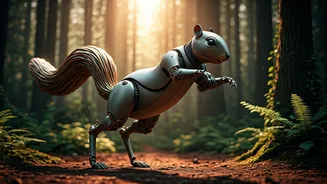Inspired by Nature
The field of robotics is increasingly drawing inspiration from the natural world, leading to some impressive designs. For example, a new soft robot was
designed based on the somersaulting abilities of the mantis shrimp. This bio-inspired approach allows robots to navigate challenging terrains and perform complex movements with greater agility. Similarly, the study of tiny insects and their ability to swim through ‘syrupy’ air is informing the design of miniature robots with specialized wings. These designs demonstrate how scientists are studying natural processes to develop advanced robotics, resulting in innovative and efficient machines. The goal is often to replicate these natural abilities for use in real-world situations, enabling these machines to perform tasks in environments previously considered inaccessible.
Squirrel-like Jumps
One of the remarkable advancements is a squirrel-like robot capable of impressive jumps. This robot's design is focused on mimicking the agility and jumping capabilities of squirrels, allowing it to navigate complex environments with ease. This development signifies progress in creating robots that can negotiate obstacles in varied terrains, expanding the potential applications for robotic technology. The research focuses not just on building robots that can jump, but also on how they jump, so that the robotic movements can be more similar to those of living organisms. These advances in biomimicry are changing how robots can be designed and how they can adapt to the environment, suggesting the potential for greater functionality and mobility in future designs.
Shark Research Influence
The inspiration for many scientific pursuits comes from unexpected sources. For one marine biologist, a close encounter with a shark set in motion a career path focused on marine biology. This anecdote illustrates how personal experiences can shape scientific interests and drive research forward. This experience likely sparked a deep curiosity about marine ecosystems and the behavior of marine life. This kind of personal connection often fuels dedication and commitment to the scientific field. The impact of such encounters emphasizes that research isn't just about laboratory work, it is also about human interaction with nature.
Walking on Water
Robotics also explores the possibilities of aquatic mobility. The ripple bug robot represents another intriguing development, which uses specialized feet to walk on water. The design of these feet and the physics behind the interaction of the robot with water surfaces are essential to making this capability possible. This innovation showcases the advancement of technology and engineering to build machines with diverse capabilities. Such water-walking robots could be useful in environmental monitoring or search-and-rescue operations. The design continues to develop with new methods being added to improve the efficiency and applicability of the robots in different environments.










